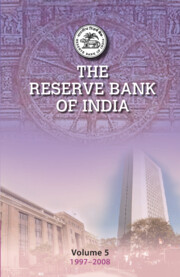Book contents
- Frontmatter
- Contents
- Tables
- Boxes
- Foreword
- Preface
- Acknowledgements
- List of Abbreviations
- 1 Introduction: Managing Liberalisation
- 2 The Macroeconomic Context
- 3 Monetary Management
- 4 Foreign Exchange Market and Management of the Capital Account
- 5 Foreign Exchange Reserves Management
- 6 Financial Markets
- 7 Public Debt Management
- 8 The Payment and Settlement Systems
- 9 Currency Management
- 10 Regulation of the Financial System – Part I: Commercial Banks
- 10 Regulation of the Financial System Part II: Other Financial Institutions
- 11 Supervision of the Financial System
- 12 Rural Credit
- 13 Financial Inclusion
- 14 Communication Policy
- 15 Organisational Change
- Appendices
- Photographs
- Select Bibliography
- Index
4 - Foreign Exchange Market and Management of the Capital Account
Published online by Cambridge University Press: 10 January 2023
- Frontmatter
- Contents
- Tables
- Boxes
- Foreword
- Preface
- Acknowledgements
- List of Abbreviations
- 1 Introduction: Managing Liberalisation
- 2 The Macroeconomic Context
- 3 Monetary Management
- 4 Foreign Exchange Market and Management of the Capital Account
- 5 Foreign Exchange Reserves Management
- 6 Financial Markets
- 7 Public Debt Management
- 8 The Payment and Settlement Systems
- 9 Currency Management
- 10 Regulation of the Financial System – Part I: Commercial Banks
- 10 Regulation of the Financial System Part II: Other Financial Institutions
- 11 Supervision of the Financial System
- 12 Rural Credit
- 13 Financial Inclusion
- 14 Communication Policy
- 15 Organisational Change
- Appendices
- Photographs
- Select Bibliography
- Index
Summary
Introduction
Between 1997 and 2008, the Indian foreign exchange (or forex) market underwent a major transformation in terms of the scale of turnover, players, institutional arrangements, and instruments. Although the Indian rupee had become convertible on current account in 1994, some of the current account transactions were still subjected to limits. These were either removed or relaxed subsequently and brought under a new legal framework, the Foreign Exchange Management Act (FEMA), 1999, which replaced the earlier, and far more restrictive, Foreign Exchange Regulation Act (FERA) 1973. Authorised dealers (ADs) were provided with more flexibility to undertake forex operations and greater freedom to manage risks.
The liberalisation of the capital account, by contrast, was a more gradual process and marked by cautious optimism. The period witnessed ‘effective’ full capital account convertibility for non-resident Indians (NRIs) and the introduction of limited liberalisation measures for capital transactions of residents. The underlying aim was to open up the forex market in line with the ongoing reforms. That expectation was so well fulfilled that the resultant transition posed problems for capital account management. Between 2001 and 2008, capital inflows occurred on a scale beyond the absorbing capacity of the economy, forcing the Reserve Bank to explore ways in which the ‘problem of plenty’ could be handled (Table 4.1).
In terms of the powers conferred by FEMA, the Reserve Bank is responsible for development and regulation of the forex market as well as management of the capital account. The measures that were taken to further open up the market during 1997–2008 necessitated changes in the legal framework and introduction of a large number of specific regulatory measures on the part of the Bank. The focus of the present chapter is on these measures.
The rest of the chapter has two main sections, dealing with the forex market and management of the capital account.
Foreign Exchange Market
Until the late 1990s, the Indian forex market was relatively shallow and had an uneven flow of demand and supply. Most transactions were spot and trade based. Transactions emanating from market expectations were rare because arbitrage opportunities between onshore and offshore financial asset markets were not freely allowed to be exploited.
- Type
- Chapter
- Information
- The Reserve Bank of IndiaVolume 5, 1997–2008, pp. 94 - 146Publisher: Cambridge University PressPrint publication year: 2023



